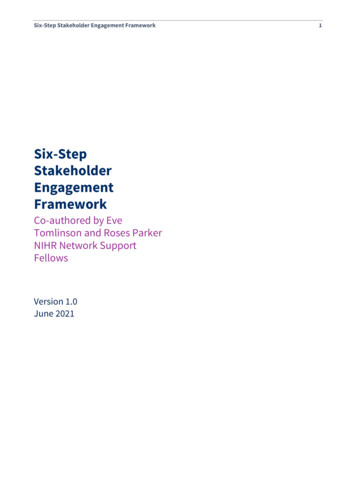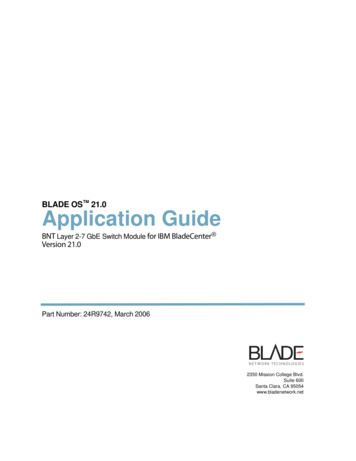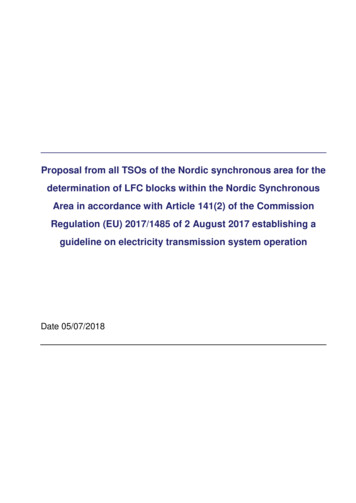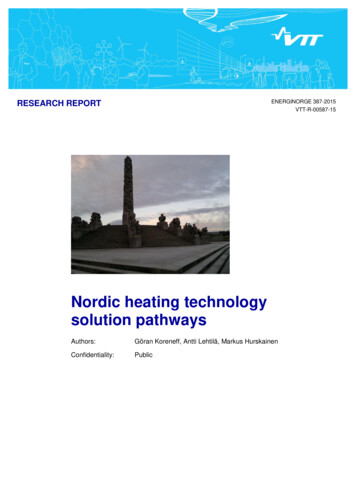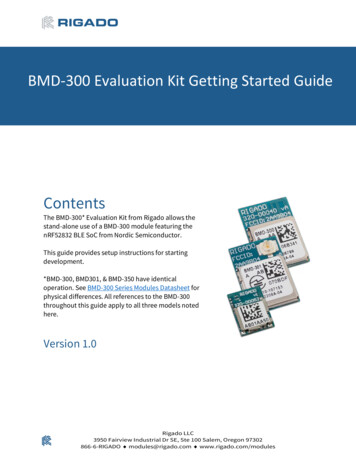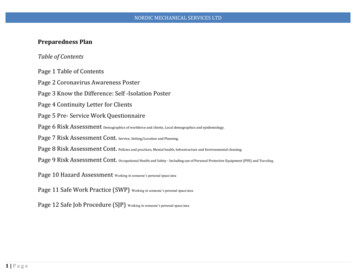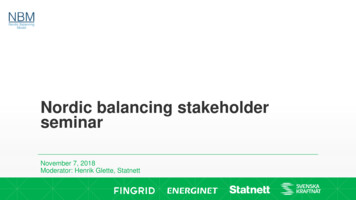
Transcription
Nordic balancing stakeholderseminarNovember 7, 2018Moderator: Henrik Glette, Statnett
Agenda10.00-10.10Welcome, practicalities and agenda10.10-10.30The Nordic balancing cooperation and the roadmap10.30-12.00The new Nordic Balancing ModelFrom frequency regulation to mACEaFRR and mFRR capacity marketsaFRR and mFRR activation markets and links to European platforms15 min imbalance settlement period12.00-13.00Lunch break13.00-13.40The new Nordic Balancing Model continuesPlan for involvement of stakeholdersPresentation from National Regulatory Agency representative13.40-14.45Panel discussion with stakeholders and NBSC member:How will the market participants be affected and how should stakeholders be involved inthe development?14.45-15.00Summary and conclusions
The Balancing Cooperation andRoadmap10.10-10.30 amNiclas Damsgaard, chair Nordic Balancing Steering Committee (NBSC)
A changing power system drives the needfor a new balancing modelThe frequency quality in the Nordic power system has gradually deteriorated More renewable generation resulting in more frequent, less predictable and largerimbalances within the operational hour More HVDC interconnectors and more frequent changes in cross-border flows Closure of conventional thermal power plants (incl. nuclear) reduces systeminertia Bottlenecks within and between bidding zones prevent efficient use of hydropower for balancing between areasIn addition to the system changes there are also regulatory changes.
Business as usual is not an alternativeTo handle the changing power system and enable the energy transformationseveral actions are needed General increase of digitalization and automationFaster and larger variability implies a need for general increased digitalization andautomation. Also necessary to handle decentralized resources as suppliers ofancillary services. 15 minute imbalance settlement periodsAllows consumption and production to follow each other more closely and revealsvalue of flexibility. Nordic Balancing Model based on modernized ACE (mACE)New balancing model to ensure operational security and efficient market
The Nordic Balancing Model covers capacity andenergy activation markets for FRRFirst generation Common Nordic capacity market for automatic FRR (aFRR)Under development. Go live Q3 2019 Common Nordic capacity market for manual FRR (mFRR)Go live Q4 2019 (preliminary) Common Nordic energy activation market for mFRRGo live Q2 2020Second generation Common Nordic energy activation market for aFRRGo live Q1 2021 European standard product for mFRR
New roles in the Nordic Balancing ModelTSO tasks Dimensioning process Collect bids Common aFRR capacity market Settlement TSO-TSO Settlement BSPs and BRPsCommon mFRR capacity market Grid model Common mFRR activationoptimization function Update balancing energyexchange plans Common aFRR activationoptimization function Bottleneck review Redispatch/internal bottlenecks Imbalance prognosis Activation request Local merit order list and manualbid activation mFRR ordering ACE calculation aFRR controller aFRR activation towards BSPs Nordic security function Price and TSO-TSO costcalculation Reporting TransparencyIT developmentfor common servicesCommon tasksCommon serviceprovider (CSP):Svenska kraftnätand StatnettNational TSOs:EnerginetFingridStatnettSvenska kraftnät CSP delivers services to all the Nordic TSOs Each TSO responsible for local activities CSP responsible for IT development to supportthe common services Increased national responsibility compared withcurrent model Market design etc. decided jointly by all TSO
Agile development with detailing andspecifications along the wayRegulatory approvalsRegulatory approvalsMarket design,High level market designOperational methodsand processesIT developmentSprint 1Clarification ofdetailsSprint 2Operation Go-live
The roadmap2018202020192021M1B - rolesQ2 2020Nordic functionsEuropeanfunctionQ2 2019Q4 2019M1A - ITQ1 2020M2 - aFRRQ1 2021Q4 202015 min ISPExisting stateCommon capacitymarket mFRR.New stateNew Imbalance PriceCommon capacitymarket aFRR.Single pricingNordic AOF for mFRRManual operator decisions from the frequency leaderMARITrial operationaFRR Energy bids, free bidsPro-rata aFRR based on frequencyNordic AOF for aFRR EnergyPICASSOBalancing Power exchange based on todays principlesBalancing Power exchange based on15 min resolution (TSO-TSO)(Scheduled mFRR as intended)NEW settlement of unintended exchangebetween TSO’s (Scheduled mFRR and aFRR asintended exch.)Frequency based BalancingPartly ACE-based balancing (mFRR)ACE based Balancing
The new Nordic Balancing Model10.30-12.00 am
From frequency regulation tomACEGunnar E. Nilssen, Statnett
Development for balancing philosophy 2000ACE in each country2000 – 2020/2021Frequency controlFrom 2020/2021mACE 0 0 0 0 0 0 0 0 0 0 0 0 0 0 0More efficient use of resourcesNetting of imbalancesMerit order bid list 0Digitalization of balancingBetter control with flowsMore clear responsibilitiesmACEcontroller
mACE control – efficient trade and nettingImbalances and available reserves in each bid-area are optimized ina central algorithm. This secures optimized use of grid capacity efficient exchange of balancing products fair settlement between buyers and sellers
mFRR in mACE control The TSO request mFRR activation for their LFC areasand decide ATC for exchange Requests are optimized in the mACE platform Calculates and distributes the optimal reserve activation Regards ATCs, bid prices, netting etc. Local TSO will activate the bids Resembles the European MARI platform
aFRR in mACE controlLocal LFC controller One controller per LFC Area (11x)Calculates the local aFRR demandSend request for activation to mACE controllerReceives correction signal for ACE calculationfrom mACE controller Activates the local BSPs according local ACE.mACE controller Collect aFRR requests from local LFC controllersCalculates the optimal activation in the LFC blockRegards bottlenecks, bid prices, netting etc.Send correction signal for ACE calculation to local LFC controllerResembles the European Picasso platform
Dimensioning of FRRGunnar E. Nilssen, Statnett
Four steps towardsthe new Nordic Balancing ModelDimensioning of Frequency Restoration Reserve (FRR)TSOs in a LFC block assess the need for available reserves for each LFC areato ensure operational securityCapacity marketThe TSO procure balancing capacity to secure availability of balancing energybidsEnergy market and activationsCombine all balancing energy bids across Europe and activate in merit orderSettlementResults in a correct price signal to BRP and BSP
Dimensioning of FRR Imbalances in each LFC area is starting point Needs to consider congestions Needs to consider energy market result(s) Netting of capacity requirements is possiblein "common balancing areas" Congestions are directional, different conditionsup-regulation / down-regulation
Dimensioning of FRR
aFRR and mFRR capacity marketsCapacity marketsRebecca Nilsson, Svenska kraftnät
Capacity marketsFRR capacity marketsToday aFRR - capacity procured nationally aFRR – energy activation pro rata on an Nordic level mFRR capacity procured nationally mFRR - Nordic energy activation marketTomorrow Common Nordic capacity markets for both mFRR and aFRR Common Nordic and European energy activation market for both mFRR and aFRR
Capacity marketsMain features of FRR capacity marketsInput1. TSO request of FRR (MW per area)2. Nordic bids in a common merit order list3. Day-ahead prognosis (prices per area and flows per border)
Capacity marketsMain features of FRR capacity marketsOutput1. Reserved FRR-capacity [MW/LFC area]2. Reserved transmissions capacity [MW/LFC area border]3. Capacity remuneration to BSP [EUR/MW]
Capacity marketsStatus of FRR capacity marketsaFRR capacity market External consultation of methodology proposals for reservation of CZC and rulesand processes Ongoing work in WG to take care of stakeholder comments form the consultation Send methodology proposals to Nordic NRAs (end of November)mFRR capacity market Nordic TSO work has just started Market design will be out on external consultation and will also need approvalfrom NRAs
aFRR and mFRR activationmarkets and links to EuropeanplatformsEnergy market and activationsFredrik Wik, Svenska kraftnät
Energy market and activationsFrom a Nordic to a European balancingmarketThe transition needs major changes
Energy market and activationsNordic Balancing Model paves the way forbalancing market integration European balancing market is based on balancing need and delivery on LFC arealevel, same as bidding zones in day-ahead. Allows precise and optimized activation based on available grid capacity An imbalance can be handled proactively (just before real-time) by mFRR or reactive (during real-time) by aFRR
Energy market and activationsEuropean market coupling overview
Energy market and activationsEuropean market coupling overviewThe European market coupling requires an increased automation and harmonised balancingprocesses Continuously updatetransmission capacitiesAuctions Electronic activation Update exchange plans Security check on submitted bids mFRR each 15 (or 1)minutes Forecast on proactive needs aFRR each 4 seconds Settlement Update transmission capacities
15 min imbalance settlementperiod15 minute imbalance settlement periodMaria Joki-Pesola, Fingrid
15 min imbalance settlement periodShorter imbalance Settlement period makes theenergy system more cost effectiveEurope is going through an energy transition which needs changesin the electricity market More intermittent RES production Less conventional production More integration – more HVDC interconnectors15 ISP gives bigger role for market players in balancingof the energy system BRPs will have more incentives to balance themselves European harmonisation – increased trading opportunities in balancingmarkets and ID market Efficient use of interconnectors
15 min imbalance settlement periodEuropean Balancing Guideline is settingthe time scheduleThe European Balancing Guideline entered into force 18 December 2017 –implementation by 18 December 2020 By three years after the entry into force of this Regulation, all TSOs shall apply theimbalance settlement period of 15 minutes in all scheduling areas while ensuring that allboundaries of market time unit shall coincide with boundaries of the imbalancesettlement period. The integration of balancing energy markets should facilitate the efficient functioning ofthe intraday market in order to provide the possibility for market participants to balancethemselves as close as possible to real time. Only the imbalances remaining after theend of the intraday market should be balanced by TSOs with the balancing market.The harmonisation of the imbalance settlement period to 15 minutes in Europe shouldsupport intraday trading and foster the development of a number of trading products withsame delivery windows.
15 min imbalance settlement periodChanges in the balancing market 15 min mFRR and aFRR price for all areas 15 min bid volumes 15 min bid prices 15 min imbalance price for all areas 15 min TSO-TSO settlement of balancing energy and imbalances15 min ISP15 min mFRR15 min ID market
15 min imbalance settlement periodThe Nordic Higher Time Resolution Project
15 min imbalance settlement periodSome of the decisions are made in anational level
15 min imbalance settlement periodMore informationIn each country we organise webinars, stakeholder meetings and seminars.National projects can be followed by the internet pages in each countryProject managers are happy to answer questions Svenska kraftnät: Nordine.Aboudrar@svk.se Energinet: XHCI@energinet.dk (Hans Christensen) Statnett: Anders.Moe@statnett.no Fingrid: Maria.Joki-Pesola@fingrid.fi
The new Nordic Balancing Model(cont.)13.00-13.40 pm
Plan for involvement ofstakeholdersJakob Aldrin, Project Manager Nordic Balancing Cooperation
ComplianceRelationshipsCommunication andinformation
eholderEngagementPlanningInfluenceRelationships & InfluenceProcesses & OrganisationValue
Survey Evaluation of this seminar Input Contact: Program manager: Jakob.Aldrin@svk.se PMO: Karin.styf@svk.seNordicBalancingModel.net
Presentation by NRArepresentativeForsyningstilsynet: The NRAs’approval processPeter Christian Olsen, Forsyningstilsynet
The NRAs’ approval process”The painless process” The TSOs publish the drafted terms and condition methodology (TCM) in publicconsultation. The NRAs prepare a shadow opinion to the drafted TCM in parallel with the TSOs’ publicconsultation. The shadow opinion is an informal feedback on the TSOs’ draftedmethodology. The TSOs submit the TCM for the NRAs approval. The submission must include the TSOs’consideration of the received consultation answers. The NRAs publish the TCM for public consultation. The NRAs approve the submitted heTCMs’impact on the markets44
The NRAs’ approval process”Bump in the road” If the TSOs do not submit the TCM within the deadline – determined in the appropriatenetwork codes and guidelines – the draft TCM(s) shall be sent to NRAs and ACER. ACERinforms the Commission, who shall take appropriate measures. If the NRAs do not accept the submitted TCM, they can send a request for amendment(RfA). If the NRAs do not manage to agree on the approval of the submitted TCM, or if they senda common request to ACER about the situation, ACER’s director will make the decisionafter having secured a positive opinion (2/3) from the Board of Regulators (BoR). A NRA can request an opinion from ACER on the application of the network rules andguidelines or the Regulation 714/2009.45
The NRAs’ approval processNational, regional and Pan European approvals Regional or Pan European approval: The NRAs cooperate and coordinate closely. At Nordic level the cooperation is done within NordREG. Related to NBM the NordREG EB TF is chaired by Thomas Vom Braucke from DUR(tvbr@forsyningstilsynet.dk) At Nordic level the formal decisions are made at European Regulators Regional Forum(ERRF). At EU level the formal decisions are made at European Regulators Forum (ERF). National approval: There are no rules on cooperation.46
The NRAs’ approval process of TCMssubmitted according to NBMApproval process refering to network codes, guidelines or national law The Nordic Balancing Model (NBM) is partly based on mandatory and voluntarydevelopment plans. In our understanding some of these plans shall be approved according to the currentnetwork codes and guidelines, while others should be approved according to national law. The TSOs are working on mapping, which development plans respectively refers to thenetwork codes, guidelines and national laws. Where appropriate and where possible under national law, the NRAs will aim to workclosely together and give the TSOs our join input to ensure appropiate solutions for theNordic Market47
The NRAs’ approval processQuestions?48
The NRAs’ approval processThank you for your attentionPeter Christian Olsenpco@forsyningstilsynet.dk 45 41 71 53 9849
How will market participants be affectedand how should stakeholders be involvedin the development?Panel discussion:Sebastian Sundberg, Head of Physical Trading, FortumHåkon Egeland, Head Adviser Market Policies & Regulatory Affairs, StatkraftConny Johansson, Energy Manager Sweden, Stora EnsoMartin Schrøder, Chief Special Adviser, Dansk EnergiAsta Sihvonen-Punkka, NBSC member, FingridModerator: Henrik Glette, Statnett
Fortum and the new Nordic Balancing concept The new Nordic balancing concept seen as positive and we expect the Baltic states tobe included in the cooperation– Real time market data to all and a “level playing field” is a must– One price – one balance– Involvement of all stakeholders in development crucial We welcome harmonization of products and rules over national borders enabling– Use of same processes and tools for all Nordic market players– Common technical specifications and validation processes– Entry of new market players and scalability of new business models Fortum must ensure that our portfolio and systems are adapted to new requirements51
NORDIC BALANCINGSTAKEHOLDERSEMINARHåkon EgelandHead Adviser Market Policies & Regulatory Affairs
How will market participants be affected and how shouldstakeholders be involved in the development Expect significant impact on several IT system ( costs) and working routines Hope to earn more money Many processes, miss clear overview of how different (uncoordinated) TSO processeseffect us and how to adapt to them in a rational way- Ongoing both by Entso-E (difficult to follow), Nordic TSO (important that harmonized and wellcoordinated) and national level (satisfactory but still challenging) Wondering to what extent we can participate in a truly Nordic and European balancingmarket- Important that trading capacity is used in a optimal way and as far as possible in a market basedway Would like a timeline with the different processes, how they interfere with each other andexpected consultation and decision stages
Stora Enso in Nordic Energy Market Total we refine 10 TWh of electricity together with Wood to valuable products In some mills we have a possibility to act in the markets In Sweden we have a site with a total storage capacity of 2000 MWh of electricity and the chargers areat the level of 200 MWThe “Battery” electrolytecontains water and wood fiberThis site:Battery 700 MWhCharger 70 MW546/11/2018The “Charger” use 18 MW eachAt this site we have 4
Summary and conclusions
Stay updated Visit our web site: http://nordicbalancingmodel.net Contact NBM Program Program Manager Jakob Aldrin: jakob.aldrin@svk.se Program Management Office (PMO): karin.styf@svk.se
New roles in the Nordic Balancing Model CSP delivers services to all the Nordic TSOs CSP responsible for IT development to support the common services Market design etc. decided jointly by all TSO Each TSO responsible for local activities Increased national responsibility compared with current model National TSOs: Energinet Fingrid


